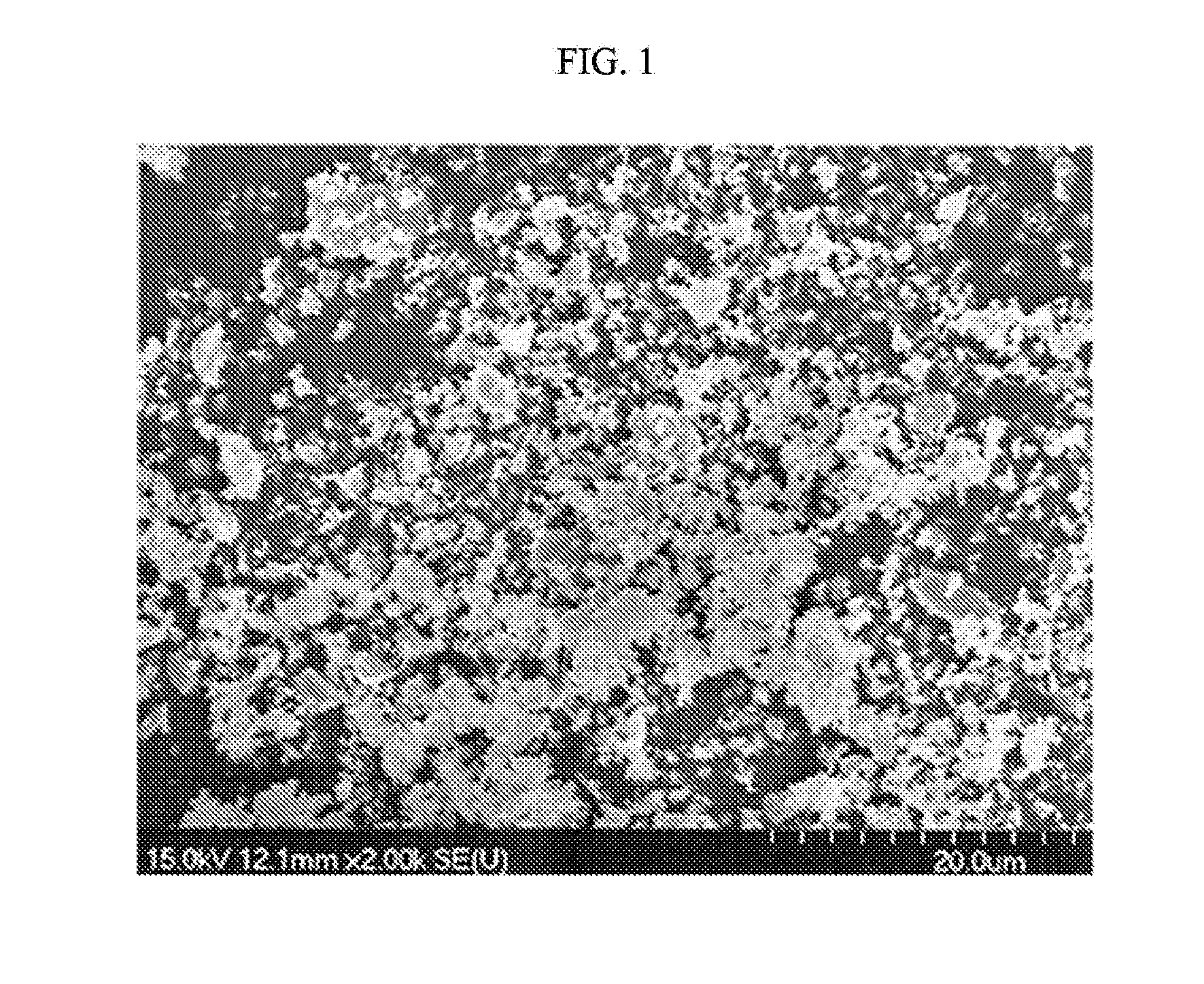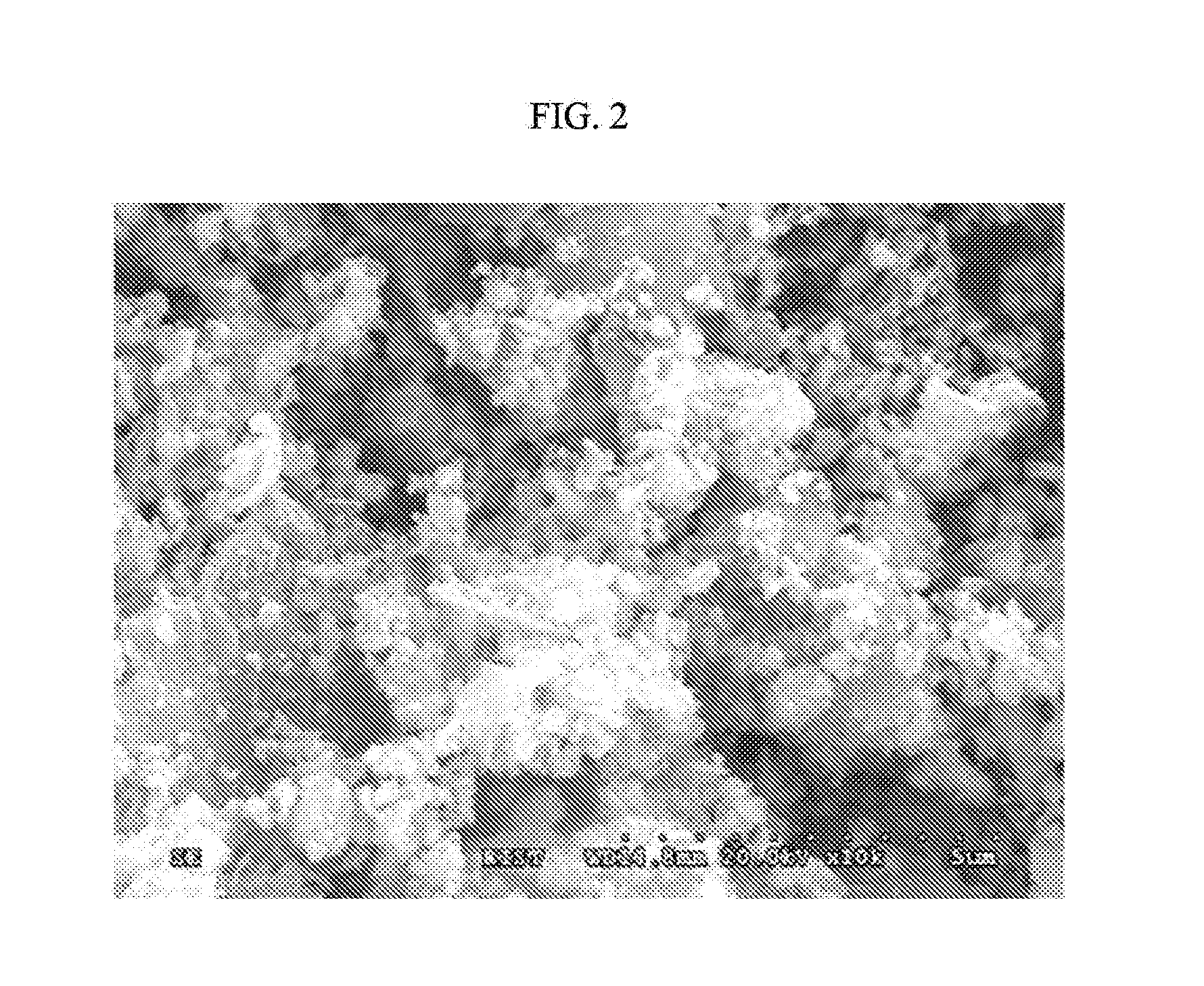Method for Manufacturing Composite Ceramic Material
a composite ceramic and manufacturing method technology, applied in the field of composite ceramic materials, can solve problems such as deterioration of stack performance, and achieve the effect of excellent electrical conductivity
- Summary
- Abstract
- Description
- Claims
- Application Information
AI Technical Summary
Benefits of technology
Problems solved by technology
Method used
Image
Examples
example 1
[0073]First, lanthanum cobaltite was synthesized as one of starting materials.
[0074]To this end, lanthanum oxide and cobalt oxide were mixed, and heated at the temperature of 1400° C. for 5 hours or more to synthesize lanthanum cobaltite. The synthesized lanthanum cobaltite was pulverized to form a powder state. The manufactured powder of lanthanum cobaltite was manufactured to have a dense and spherical shape without pores between primary particles as shown in the picture taken by the scanning electron microscope (SEM) of FIG. 1. The average particle diameter of the manufactured lanthanum cobaltite was about 3 μm.
[0075]Next, the nitrate aqueous solution was manufactured. The composition of the nitrate aqueous solution was adjusted by weighing and mixing nitrates so that the composition of the finally formed perovskite ceramic was (La,Ca) (Cr,Co,Cu)O3 (hereinafter, referred to as ‘LCCAF’). The accurate composition of LCCAF used in the present Example was (La 0.8Ca0.2)(Cr0.1Co0.6Cu0....
example 2
[0089]In Example 2, the amount of synthetic powder manufactured according to Example 1 was increased to be 250 g in one batch, and physical properties with pure LCCAF powder were compared. (The amount of synthetic powder synthesized in Example 1 is 100 g in one batch.)
[0090]First, pure LCCAF powder was synthesized by adding only the citric acid to the nitrate aqueous solution weighed in a stoichiometric composition. In addition, synthetic powder was synthesized by the same method as Example 1 for the purpose of comparison therewith. In this case, the composition of lanthanum cobaltite in synthetic powder was set so that the ratio of lanthanum cobaltite in powder obtained after calcining was 50 wt % . Hereinafter, synthesized LCCAF powder is called “pure LCCAF powder”, and synthetic powder synthesized for comparison is called “50% synthetic powder”.
[0091]The powders synthesized as described above were shaped into disks having the diameter of 25 mm by each adding 1.0 wt % of polyvinyl...
example 3
[0094]In Example 3, synthetic powder manufactured according to Example 2 was applied as a contact material to the separation plate of the solid oxide fuel cell, and electric characteristics of the fuel cell were examined.
[0095]The sample used in this experiment is 50% synthetic powder synthesized according to Example 2.
[0096]Synthesized 50% synthetic powder, the organic combining material, the dispersion material and the solvent were mixed with each other to manufacture the slurry.
[0097]This slurry was put into the syringe-shaped container, and applied in a linear form on the solid oxide fuel cell separation plate by using a dispenser device. Further, this was sintered in the air at 850° C. for 4 hours.
[0098]In the used solid oxide fuel cell, the single cell was formed of LaSrCoFeO3 (LSCF) anode, yttria stabilized zirconia (YSZ), and Ni—YSZ cathode, the separation plate was formed of a stainless steel material (ferritic steel), and the sealing material was glass.
[0099]In this case, ...
PUM
| Property | Measurement | Unit |
|---|---|---|
| particle diameter | aaaaa | aaaaa |
| particle diameter | aaaaa | aaaaa |
| particle diameter | aaaaa | aaaaa |
Abstract
Description
Claims
Application Information
 Login to View More
Login to View More - R&D
- Intellectual Property
- Life Sciences
- Materials
- Tech Scout
- Unparalleled Data Quality
- Higher Quality Content
- 60% Fewer Hallucinations
Browse by: Latest US Patents, China's latest patents, Technical Efficacy Thesaurus, Application Domain, Technology Topic, Popular Technical Reports.
© 2025 PatSnap. All rights reserved.Legal|Privacy policy|Modern Slavery Act Transparency Statement|Sitemap|About US| Contact US: help@patsnap.com



